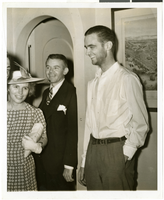Search the Special Collections and Archives Portal
Search Results
Howard Hughes in New York, 1938 July
Level of Description
File
Archival Collection
Howard Hughes Public Relations Photograph Collection
To request this item in person:
Collection Number: PH-00373
Collection Name: Howard Hughes Public Relations Photograph Collection
Box/Folder: Folder 09
Collection Name: Howard Hughes Public Relations Photograph Collection
Box/Folder: Folder 09
Archival Component

Photograph of Howard Hughes at Grover Whalen's house, New York, 1938
Date
1938
Archival Collection
Description
A candid photograph of Howard Hughes at Grover Whalen's house.
Image

Photograph of Howard Hughes at Grover Whalen's house, New York, 1938
Date
1938
Archival Collection
Description
A bust view of Howard Hughes at Grover Whalen's house.
Image

Photograph of Howard Hughes at Grover Whalen's house, New York, 1938
Date
1938
Archival Collection
Description
A close up of Howard Hughes, at Grover Whalen's house.
Image

Photograph of Howard Hughes and others with a XH-17 helicopter, Culver City, California, October 23, 1952
Date
1952-10-23
Archival Collection
Description
Howard Hughes (second from left) standing in front of the experimental helicopter XH-17, Flying Crane in October 1952. From left to right: Rea Hopper, Director of the Aeronautical Division, Hughes Aircraft Company; Howard Hughes; Clyde Jones, Director of Engineering, Hughes Tool Company Aeronautical Division; Warren Reed, Assistant; Colonel Carl E. Jackson, Air Research and Development Headquarters, Baltimore; Gale J. Moore, Pilot; and Chal Bowen, Flight Engineer/Co-pilot.
Image

Photograph of Howard Hughes and others with the XH-17 helicopter, Culver City, California, October 23, 1952
Date
1952
Archival Collection
Description
Howard Hughes (second from left) standing in front of the experimental helicopter XH-17, Flying Crane, with others (from left to right): Rea Hopper, Director of the Aeronautical Division, Hughes Aircraft Company; Hughes; Clyde Jones, Director of Engineering, Hughes Tool Company Aeronautical Division; Warren Reed, Assistant; Colonel Carl E. Jackson from Air Research and Development Headquarters, Baltimore; Gale J. Moore, Pilot; possibly Chal Bowen, Flight Engineer/Co-pilot, and an unidentified man, on October 23, 1952.
Image

Map of city of Las Vegas, Nevada, October 1, 1940
Date
1940-10-01
Description
'Compiled by C.D. Baker, Oct. 1, 1940.' Scale [ca. 1:11,400]. 1 in. to 950 ft. Cadastral map.
Image

Photograph of Howard Hughes in the Northrop Gamma Racer, New York, 1936
Date
1936
Archival Collection
Description
The black and white view of Howard Hughes in New York. Text printed on a card included with the image: "Howard Hughes and Albert Lodwick beside Northrop Gamma, surrounded by a crowd at the Floyd Bennett Airport after breaking the record from Miami to New York in 4 hours and 21 minutes (distance 1095 miles; average speed 250 mph; high speed 290 mph). This bettered Jimmy Wedell's July 1933 record by 36 minutes. New York, New York."
Image

Map of the city of Las Vegas, Nevada, June 1, 1946
Date
1946-06-01
Description
Scale [ca. 1:9,600. 1 in. to approx. 800 ft.]. Cadastral map. 'Compiled by Pioneer Title Insurance &Trust Company.' 'By Jack Asher, State Nev. Reg. Engr. No. 305.' 'Issue 5, 6/1/46.' Includes indexes. Pioneer Title Insurance &
Trust Company
Trust Company
Image

Photograph of three faces of Howard Hughes, New York, July 14, 1936
Date
1936-07-14
Archival Collection
Description
Three head shots of Howard Hughes in the back seat of a car enroute to his hotel in New York.
Image
Pagination
Refine my results
Content Type
Creator or Contributor
Subject
Archival Collection
Digital Project
Resource Type
Year
Material Type
Place
Language
Records Classification
